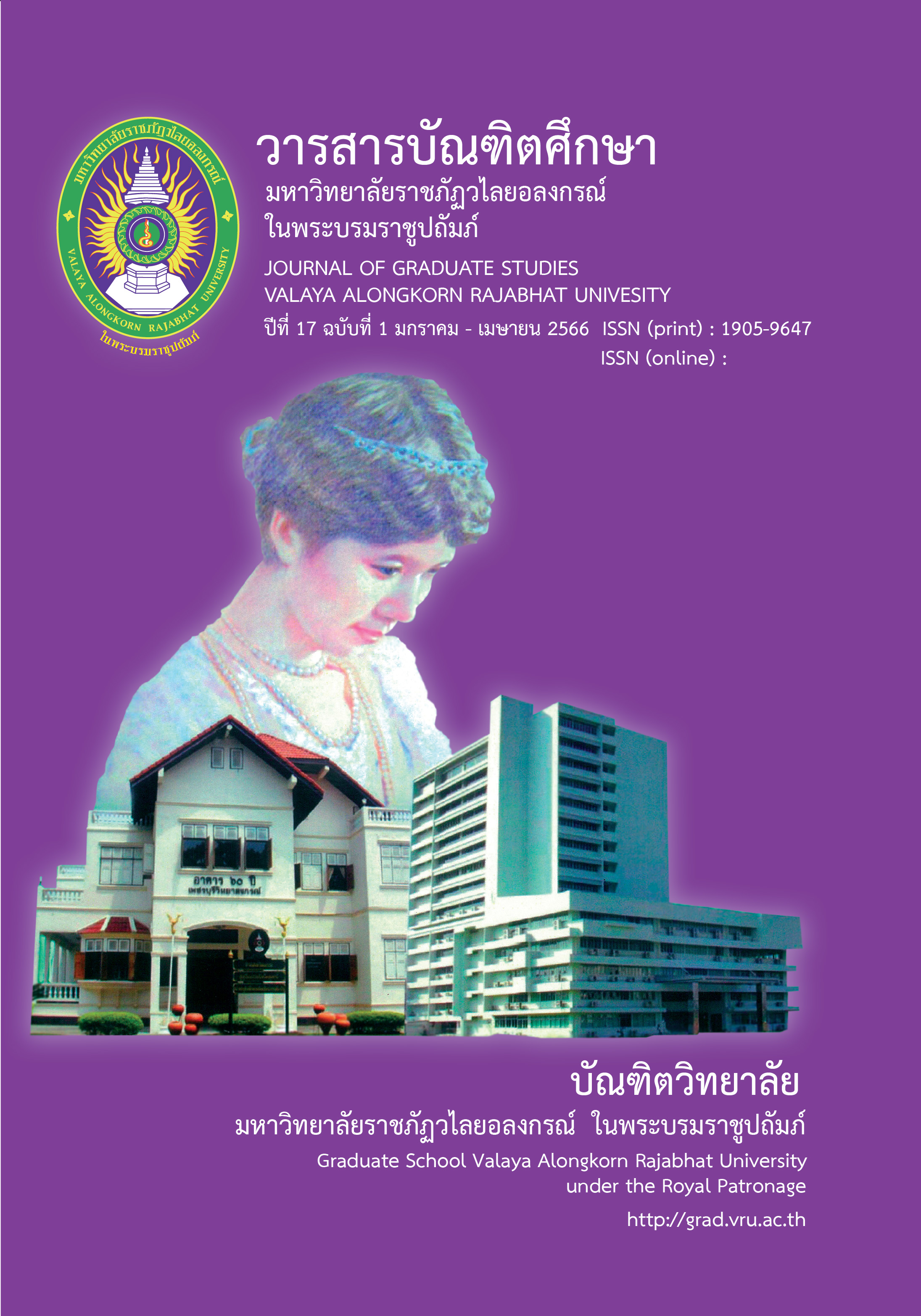A DEVELOPMENT OF CAUSAL MODEL OF PERSONALITIES AND COOPERATIVE EDUCATION ACHIEVEMENT
Main Article Content
Abstract
The purposes of this research were to: 1) develop the causal relationship model of personalities and cooperative education achievement, and 2) examine the model consistency with the empirical data. The research samples consisted of 500 Suranaree University of Technology (SUT)’s cooperative education students who undertook cooperative education at least 16 weeks. The questionnaires were used as the data collection tool. Data were analyzed using descriptive statistics, factor analysis and structural equation modeling.
The major findings are as follows: 1) the causal relationship model of personalities and cooperative education achievement had a good fit to the empirical data (χ2= 1361.72, df = 1154, p = .48, χ2/df = 1.18, RMSEA = .00), 2) the personality neuroticism had the most positive direct effects size as .36, openness to experience as .28**, agreeableness as .21*, conscientiousness as .13*, and extraversion as .08** at the significant level of .05 respectively. The variance of cooperative education achievement can predict 71 percent.
Article Details

This work is licensed under a Creative Commons Attribution-NonCommercial-NoDerivatives 4.0 International License.
บทความทุกเรื่องได้รับการตรวจความถูกต้องทางวิชาการโดยผู้ทรงคุณวุฒิ ทรรศนะและข้อคิดเห็นในบทความ Journal of Global of Perspectives in Humanities and Social Sciences (J-GPHSS) มิใช่เป็นทรรศนะและความคิดของผู้จัดทำจึงมิใช่ความรับผิดชอบของบัณฑิตวิทยาลัย มหาวิทยาลัยราชภัฏวไลยอลงกรณ์ ในพระบรมราชูปถัมภ์ กองบรรณาธิการไม่สงวนสิทธิ์การคัดลอก แต่ให้อ้างอิงแหล่งที่มา
References
Bandura, A. (1997). Self-efficacy: The exercise of control. New York: W. H. Freeman.
Bhiromrat, K. (2011). Patčhai thī songphon tō̜ phonsumrit thāngkānrīan tāmlaksūt kǣnklāng kānsưksānaphư̄nthān Phutthasakrāt 2551 khō̜ngnakrīan chanmatthayomsưksā pīthī 1 læ chan matthayom sưksā pīthī 4 Rōngrīan sāthit mahāwitthayālai rātchaphat sūansunantha [Factors effected to the learning outcome according to basic education curriculum B.E. 2551 of Mattayomsuksa 1 and 4, Demonstration School Suansunandha Rajabhat University]. Research report. Suansunandha Rajabhat University.
Chouynuu, K. (2009). Mōdēn chœ̄ngsāhēt khō̜ng kānpatibatngān bǣpklum: Ittipol khō̜ng bukkhalikkaphāp hāʻ ongprakō̜p songphān khwāmrū kīaoka pkānthamngān bǣpklum Bukkhalik laksana phatwanprakanphrung læ patisamphan [The causal model of team-based performance: the mediating effects of five-factor personality via teamwork knowledge, trait procrastination, and their interaction]. Master’s thesis. Chulalongkorn University.
Costa, P. T. & McCrae, R. R. (1922). NEO PI-R: professional manual. Odessa, FL: Psychological Assessment Resources.
Darachai, W. (2011). Patčhai thī kīaokhō̜ng kap kānraprū khwāmsāmāt khō̜ngton dānkānrīan khō̜ng nakrīan chūangchanthī 2-3 [Factors related to academic self-efficacy of second and third level students]. Master’s thesis. Srinakharinwirot University.
Eysenck, H. J. (1960). Personality and behavior therapy. Journal of the Royal Society of Medicine. 53(7), 504-508.
Ghorbani, F. & Montazer, G. A. (2015). E-learners’ personality identifying using their network behaviors. Computer in Human Behavior. 51, 42-52.
Giluk, T. L. & Postlethwaite, B. E. (2015). Big five personality and academic dishonesty: A meta-analytic review. Personality and Individual Differences. 72, 59–67.
Hackman, J. R. & Lawler, E. E. (1971). Employee reactions to job characteristics. Journal of Applied Psychology. 55(3), 259–286.
Hackman, J. R. & Oldham, G. R. (1980). Work Redesign. Philippines: Addison-Wesley.
Intarawong, S. (2017). Ittipol rawāng kānraprū khwāmsāmāt naitonʻēng Kānraprū laksanangān thī tonpatibat læ khunnaphāp chīwit thīdī naikān thamngān thīmīphon tō̜kānpatibatngān khō̜ng buklākō̜n nai sathāban ʻudom sưksā klummai [Influence of perceived self-efficacy, job characteristics and quality of working life on job performance of staff in new university association]. Master’s thesis. Rajamangala University of Technology Thanyaburi.
Kaiyawan, Y. (2013). Kānwikhro̜ sathit lāitūaprǣ samrap ngānwičhai [Multivariate statistical analysis for research]. Bangkok: Chulalongkorn University.
Leutner, F., Ahmetoglu, G., Akhtar, R. & Chamorro-Premuzic, T. (2014). The relationship between the entrepreneurial personality and the big five personality traits. Personality and Individual Differences. 63, 58–63.
Li, J., Wang, Y. & Xiao, F. (2014). East Asian International students and psychological well-being: A systematic review. Journal of International Students. 4(4), 301-313.
Mesidor, J. K. & Sly, K. F. (2016). Factor that contribute to the adjustment of International students. Journal of International Students. 6(1), 262-282.
Musikasut, J. (2013). Patčhai thāngdān laksana bukkhalikkap hāp læ khunlaksana ngān thīmī ittipol tō̜ kānpraptūa naikān thamngān khō̜ng phanakngān naiklum ʻutsāhakam chinsūan yānyon [Factors of personality and job characteristics influencing work adaptation of staff in auto parts industry]. Master’s thesis. Rajamangala University of Technology Thanyaburi.
O'Connor, M. C. & Paunonen, S. V. (2007). Big five personality predictors of post-secondary academic performance. Personality and Individual Differences. 43(5), 971–990.
Roy, C. & Andrews, H. A. (1991). The Roy adaptation model: The definitive statement. Norwalk, CT: Appleton & Lange.
Roy, S. C. & Andrews, H. A. (1999). The Roy adaptation model. Stamford, Conn.: Appleton & Lange.
Rujiprak, V. (2016). Cultural and psychological adjustment of international students in Thailand. The Journal of Behavioral Science. 11(2), 127-142.
Sookpotharom, P. (2010). Sahakitsưksā: Phatthanā khunnaphāp bundit Tām nǣokhit Rūčhakton Rūčhakkhon Rūčhakngān [Cooperative education: The development of student quality based on the idea of “self-knowledge, people knowledge, and work knowledge]. Bangkok University Research Conference. (pp. 207-213) Bangkok: Bangkok University.
Sripan, P. (2021). khwām samphan rawāng bukkhalikkaphāp 5 ʻIngprakō̜p kap prasitthiphon nai kānthamngān khō̜ng phanakngān thanākhān Thitkō Čhamkat (Mahāchon) Sūanngān khūapkhum læ bō̜rihān sinchư̄a rāiyō̜I [Relation between big five personality and operational effectiveness of retail credit and collection department of Tisco bank public company limited]. Master’s thesis. Srinakharinwirot University.
Srisa-an, W. (2013). Kānbanyāi Rư̄ang Pradchayasahakitsưksa [Lecture on philosophy of cooperative education]. [Slide PowerPoint].
Suranaree University of Technology. (2006). Rāingān kānpramœ̄n phonsumrit khō̜ng khrōngkān sahakitsưksā namrō̜ng khō̜ng prathedthai [Performance evaluation report of the pilot cooperative education program in Thailand]. Nakhon Ratchasima: Suranaree University of Technology.
Supapol, N. (1984). Tritdī bukkhalikkaphāp [Personality theory]. Bangkok: Srinakharinwirot University.
Thai Association for Cooperative Education. (2012). Khūmư̄ kānčha tsahakitsưksā [Cooperative education manual]. Bangkok: Print City.
Trifonovich, G. J. (1977). Culture learning/culture teaching. Educational Perspectives. 18-22.
Vanichbuncha, K. & Vanichbuncha, T. (2015). Kānchai SPSS for Windows Naikān wikhro̜ khō̜mūn [Using SPSS for windows in data analysis]. Bangkok: Chulalongkorn University.
Zhou, M. (2015). Moderating effect of self-determination in the relationship between Big Five personality and academic performance. Personality and Individual Differences. 86, 385-389.


